

 |
 |
Despite what the title says, this image account spans a two day period from November 30th to December 1st 2008. These two dates had been on my mind for quite some time. It was well known in advance that a spectacular conjunction of the planets would group together into, what could be, the ''night sky event of the year'' as some people were calling it. The photogenic potential was more than attractive to me so I was looking forward to both days. On Sunday November 30th planets Venus and Jupiter would be only 2 degrees apart with a slender crescent Moon on show. The view would reach a climax on December 1st for European observers when planet Venus itself would be occulted by the Moon. This was certainly an opportunity not to be missed!. The show had already begun a week earlier with both planets visible in the evening sky some distance apart. As the count down began I could see both bodies getting closer each day. I was fortunate enough to get images of the planets on November 27th, 28th, and 29th, however due to freezing fog the images were not very good. I had crossed my fingers for clear weather on the following two days. So, I will take each of the two sessions in turn below.
On the evening of November 30th both Venus and planet Jupiter would be at their closest together. Only some 2 degrees (4 full Moon diameters) of sky would separate the pair. Luckily the forecast was excellent, the fog was due to vanish leaving a clear and crisp evening in it's wake. The forecast kept it's promise. That afternoon was the classic sunny Winter's scene. The sky was clear and blue with excellent transparency, the Sun was shinning, and the air was crisp and sharp. A substantial frost was already forming and the glow of the setting Sun was nature's way of saying ''time for action''. A quick glance into the high southern sky showed brilliant Venus in an instant, straight above was Jupiter. It hit me that we were very lucky to get such a splendid conjunction. One reason is that it was an evening sky event. More people (members of the public - not just observers) would get a chance to see it without much effort. The other reason was the height of the planets above the horizon. Many potentially very attractive conjunctions in the past have occurred low in the sky, or before dawn. When this happens only the dedicated individual with good experience will take advantage of the opportunity. During 2007 I observed a brilliant conjunction of the Moon and Saturn, followed by a daylight occultation of the same bodies. That was an impressive event and I wondered as I had one last look up at the sky, if this would match it in quality. I would soon find out.
I got my gear together and headed out into the chilly air. The temperature had really dropped like a stone. My breath was condensing in a big way and I nearly slipped several times on the icy ground. I noticed there was some very nice convective clouds around. One in particular caught my attention. On the eastern horizon was a huge cumulonimbus cell which was illuminated an intense pink colour by the setting Sun. The anvil began to collapse around it, however a skinny updraught tower grew up from it's rear reaching an incredible height in vertical extent. I had never seen anything like it before, the cloud looked like a huge pink Swan. I should have taken an image of it but time was pressing, and besides, I was in planet mode now. Down the road I noticed a nice 'volcanic sunset' with strange pink and purple after-glow bands and rays climbing high into the sky. Twenty min's later I arrived at my location.
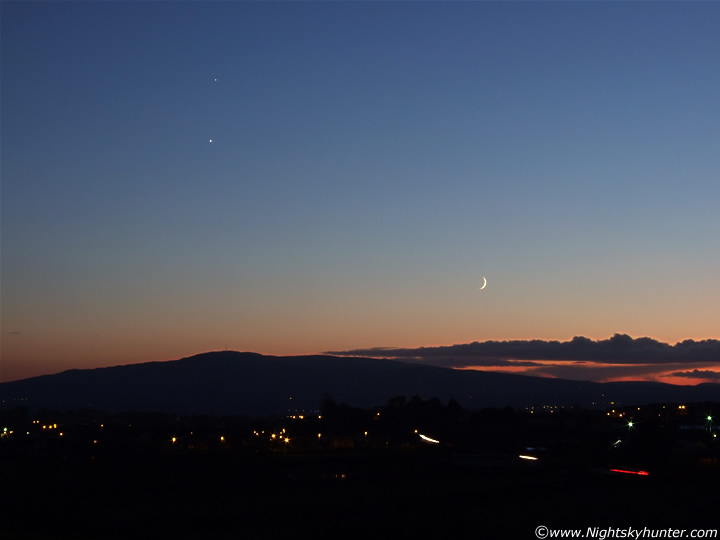 |
16.55 UT. I live in Maghera, N. Ireland. In my opinion the best photogenic potential could only be gained by going to high ground, at least high enough to see the mountains. I decided that the best place to go at short notice would be the same location I use to watch thunderstorms during the Summer months. So here I was, just outside the town itself on very high ground. A quick scan around confirmed that I had made the correct decision by being here. The Sun had sank below the horizon alarmingly quickly leaving me to enjoy this wonderful view. The sky was clear and blue, and the orange after-glow from the Sun in the SW only added to the scene. Jupiter (above) and Venus (below) where already at their closest to one another and orientated in an almost perfect vertical line. They looked great over the top of Slieve Gallion Mountain in the S. The environment was at that perfect moment when the sky still held nice colour which contrasted with the already dark landscape below. With many cars soaring in and out of the town along the Coleraine Road I knew it was time to take images. So, here's all three celestial bodies at once. A nice line of cumulus can be seen to the R in the distance moving from N to S. I suspected that the lowering Moon might look nice above them.
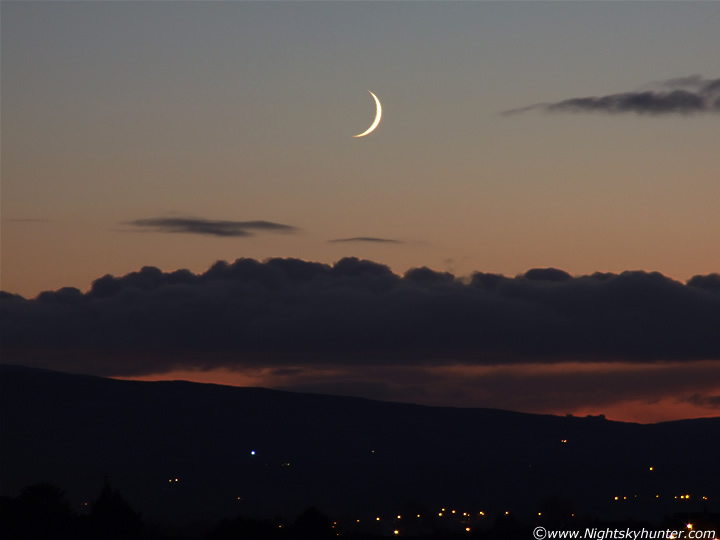 |
17.02 UT. This is a 300mm shot of the waxing crescent Moon above that line of cumulus over the mountains on a bed of deep orange sky-glow. Those lights are from houses located along the mountain. The area to the R is the road up to the Glenshane Pass.
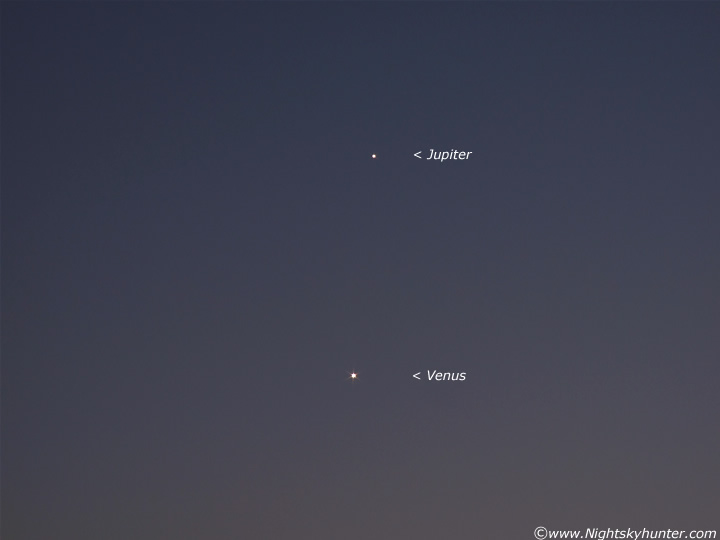 |
17.02 UT. Keeping the camera at 300mm I took this close up of both planets. I closed the aperture down to get this star-burst effect. There's one on Jupiter too, but it's fainter. On the high resolution version I can see one of Jupiter's Moons. By the way, these images are all low resolution on here. I really wish I could have put them up at a larger size because they look so much better. Even at 800 pixels in length they look much better.
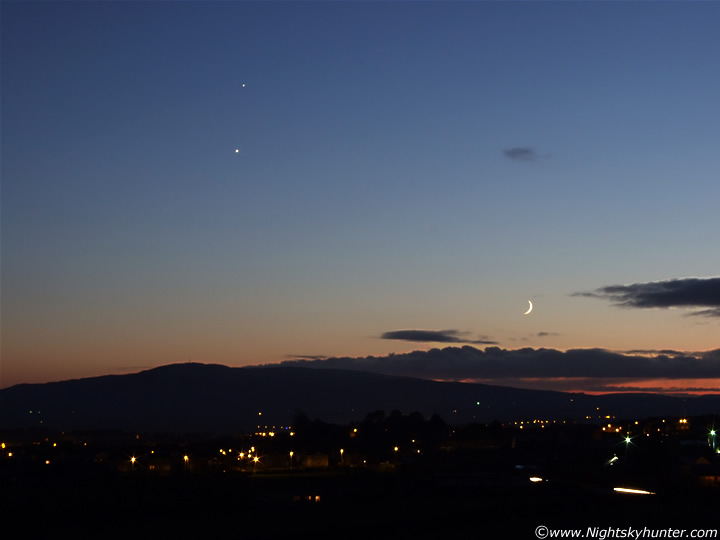 |
17.04 UT. The view of this conjunction was absolutely beautiful. Seeing the two brightest planets in the sky and a crescent Moon at the same time with such clarity was a real treat. Even if I was clouded out on the following day I would have been happy enough just to see this. The foreground lights belong to homes along Crewe Road. The car trails to the R are on the Coleraine Road. The town of Maghera is marked by the distant lights. It's quite an interesting area where I live. There are mountains in the NW, W, SW, and S, however the eastern side is more or less flat ground. Those mountains tend to lift the air mass approaching from that direction which often leads to some interesting weather phenomena.
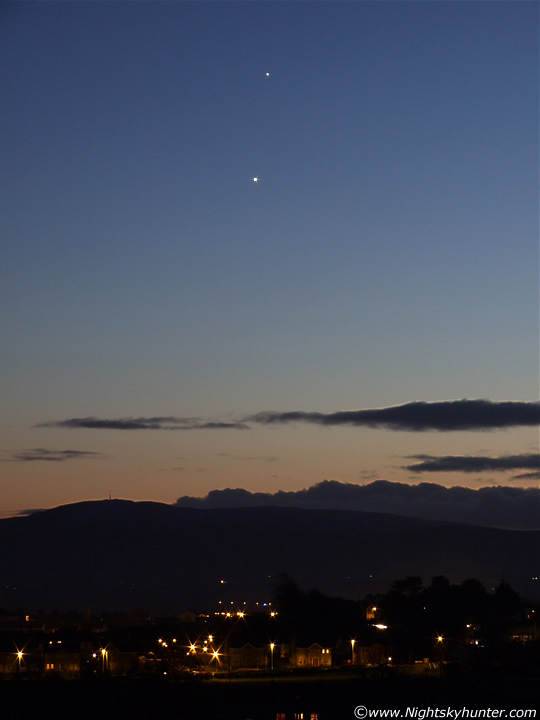 |
17.10 UT. Vertical/portrait capture of both planets above Slieve Gallion. With the exception of that distant cumulus the entire sky was clear. It was as if it was meant to happen. I did a quick measurement of the distance between Jupiter and Venus. With my hand held at arm's length I could see that one thumb diameter filled the gap, that's about 2 degrees. A finger is equal to 1 degree (2 full Moon diameters), thumb is equal to 2 degrees, 3 fingers to 5 degrees, fist to 10 degrees, and a fully splayed hand to 20 degrees. This is a very handy (excuse the pun) way to measure angles in the sky. It's surprisingly accurate too, as long as your hand is at arm's length. I use this method all the time during day and night. It could be used to measure the height of a rainbow or funnel cloud for example.
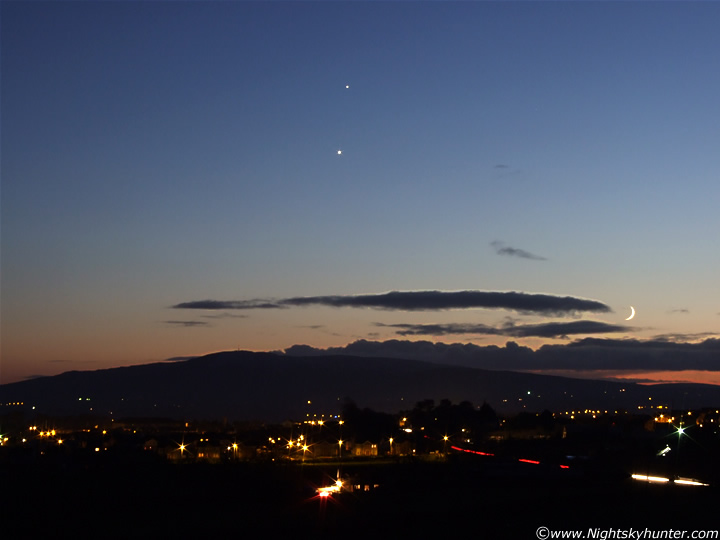 |
17.11 UT. It's at times like this when I think that Mother Nature sure is wonderful. This was so peaceful looking. I was enjoying it so much that time seemed to stand still, or at least I had no perception of it. I know I'm really engaged by the sky when this happens. The twilight was getting a little darker so I opened the shutter for longer to get those car trails. The row of six yellow lights to the L belongs to the top floor of St Patrick's College where I spent my years in secondary education. I recall during a Biology class how we were introduced to a chapter on Astronomy. At that time I knew nothing of the subject. In fact, I couldn't even name all the planets in the correct order from the Sun (I'm not joking). If I only knew back then how much an important part of my life this subject would become in later years, or that I would be standing in the middle of nowhere with a passion for taking images of the sky like this. It's funny how things change with time. I could give those teachers a lesson on Astronomy now!
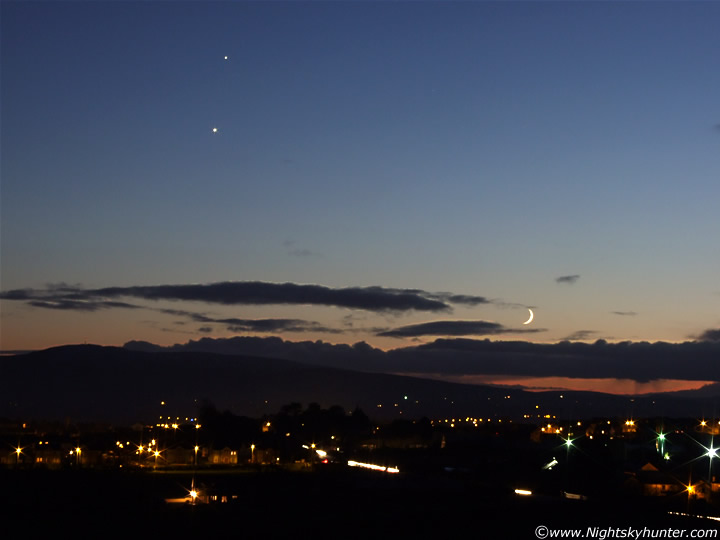 |
17.13 UT. I was switching between taking images and video footage. I noticed that the Moon was getting lower so I had to try my best to get a decent capture. That row of cumulus is producing light sleet showers of the Sperrins now.
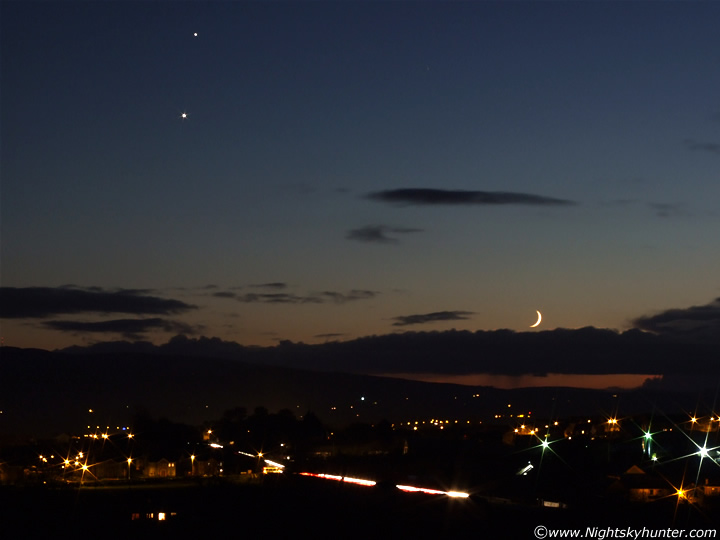 |
17.18 UT. Darkness is beginning to creep over the sky. I was able to get longer car trails now. The Moon was changing colour from brilliant white to a slight orange hue, an obvious visual indication that it was going to set soon. The town of Maghera itself is actually located in a small depression at the base of the mountain. The white car trails in the distance vanish at the crest of a hill, then there's a rapid drop into the town. This is why the majority of the town lights cannot be seen from here, although you can see the sky glow above them.
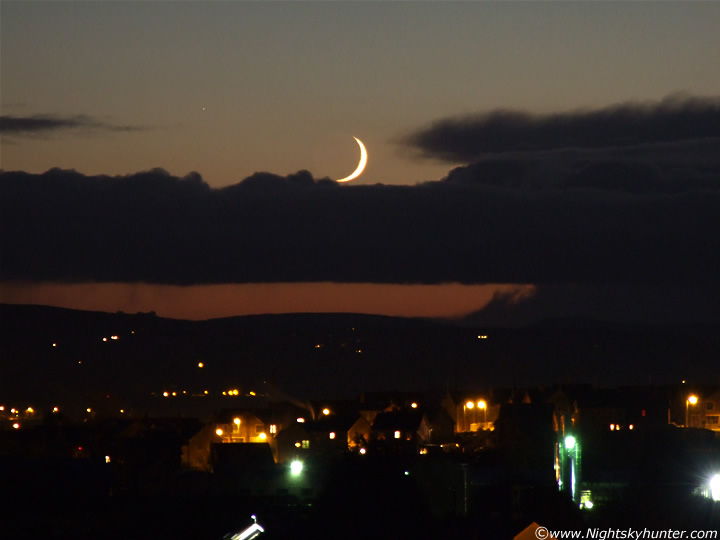 |
17.21 UT. I really liked this scene at the time. Looking SW using the 300mm lens again. The crescent Moon is about to drop behind that row of cu. The clouds are moving from R to L (N to S). A larger mass of cloud is threatening to end the show moving in from the N. You can actually see faint earthshine to the L of the crescent and a slight 'bump' at the inside centre of the crescent which marks the presence of one or two very large impact craters. I'm sure my friend John McConnell could identify those craters for me. He has the best Moon knowledge than anyone else I know. Those sleet showers might be falling as virga now. The dark bumps on the mountain top mark the top of the Glenshane Pass. There's a star to the L of the Moon, I assume it's located in SW Sagittarius but I don't know its designation. I like the effect of the chimney smoke blowing to the S in the foreground.
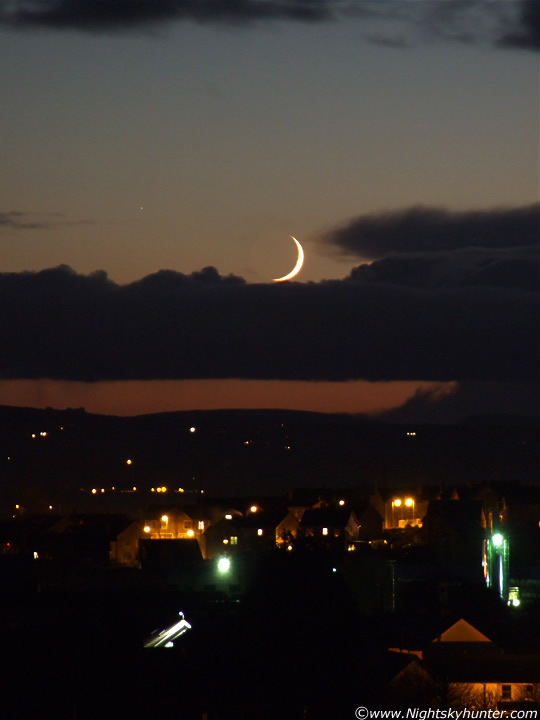 |
17.22 UT. Vertical shot of the same scene. The green light to the R belongs to a local factory. That type of light is now illegal thanks to the new light pollution laws out here. It looks OK here at dusk but when it gets fully dark it casts a very bright green cone of light in all directions upward into the sky. On a night with alot of moisture content the results can ruin all the stars on the western sky dome. A simple light shield would solve that problem. A weaker light which points down would not only help preserve the night sky, but save the company money and energy in the long run. I hope the company is reading this. I really should contact my local council about this problem. By law they should be doing something about it, and a few other sources in the town too. Anyway, enough of me giving off.
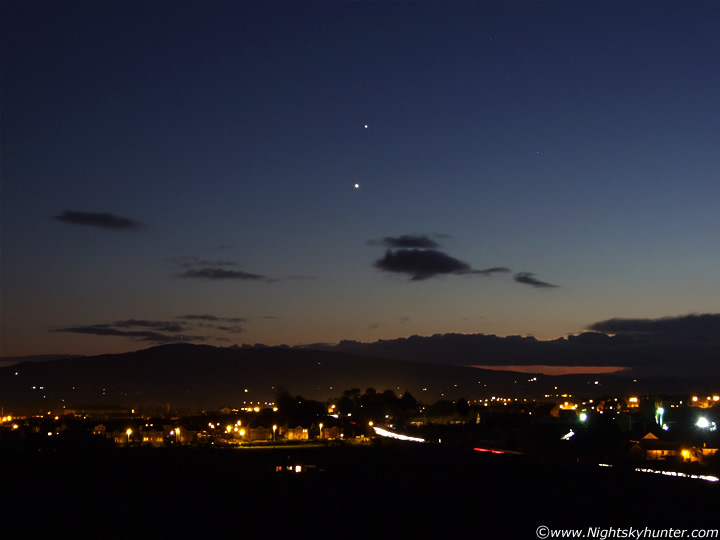 |
17.24 UT. Bye bye Moon. Hopefully I will see you tomorrow. I was trying to visualize what the scene would be like on Monday by imagining the Moon beside the planets. It should look amazing. The three stars to the R forming a triangle are located in northern Sagittarius. At this point there was a very strong frost forming and I was freezing. I couldn't operate the controls of my camera in an effective manner with gloves on so I had them off during the entire session which defeated the point of having them in the first place. My fingers were red and painful then felt awkward and slow in movement. The frost was really getting to me. I had to rub my hands against my jeans to get some heat and feeling back. If you hear a strange sound in the video clip below then that's what I'm doing. A few people have suggested to me about using fingerless gloves for photography. I must give them a go.
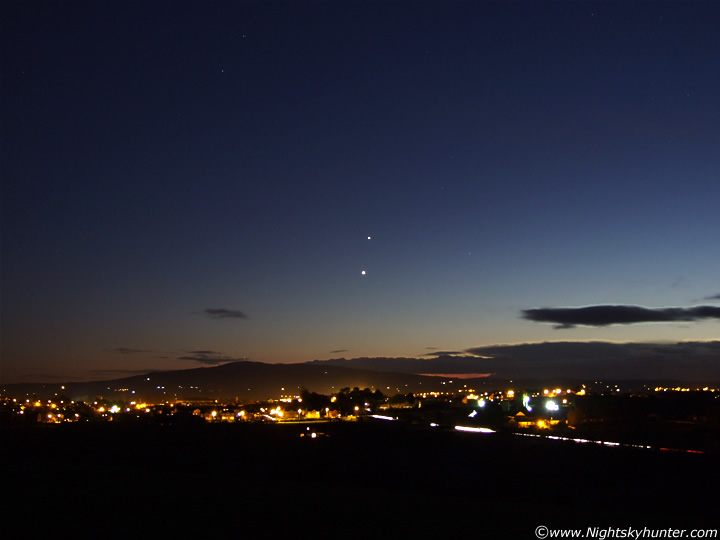 |
17.29 UT. With a close conjunction it's all to tempting to zoom in for a close capture. However, by doing this you will make the planets seem further apart than they actually are because the gap between the two becomes larger. Perhaps the only way to counteract that effect is to get some kind of foreground in the image for a sense of scale. Keeping this in mind I decided to zoom out for a wide shot to show how close they really where. A few degrees is not a large area of sky. These are all ISO 200 with a closed aperture and appropriate shutter. The stars above are in Capricornus. The visual double star is Alpha.
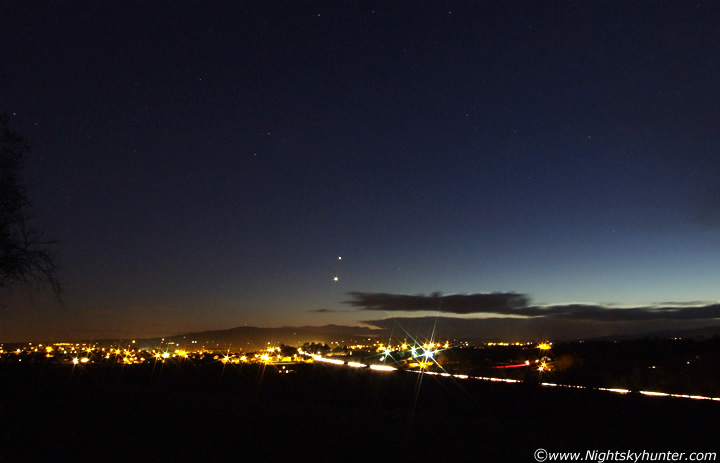 |
17.37 UT. Lens is now at 28mm and captures perfectly just how close Jupiter and Venus are. The ISO is up to 400 which is why the image looks a little grainy. To the L of the conjunction is Capricornus, there's a blue haze near Alpha, I assume it's a lens flare. R of centre is southern Aquila and Scutum. Serpens Cauda to the far R. It was so cold now that my breath was forming billowing icy clouds every time I exhaled. I was worried that I would fog over the lens so after setting the 2 sec timer I stood well back from the camera during the exposure. My fully charged batteries died very quickly in such freezing conditions so I put in a new set. That took some going in the dark when you couldn't feel your fingers!. You wouldn't think it was cold by looking at the images, that's because the colour of the town lights creates a 'warm' feeling to the image. Those car trails were getting more tempting so I decided to go down hill to take advantage of them.
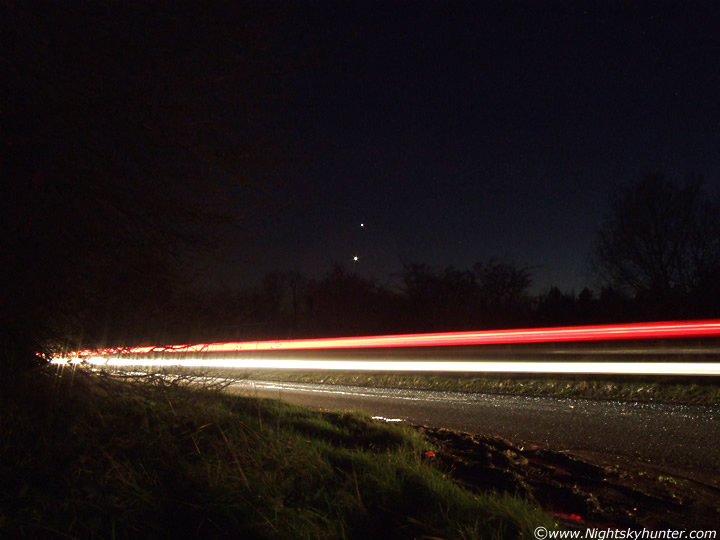 |
17.43 UT. I'm now located on the east side of the Coleraine Road just a few metres from the road itself looking SW. The most spectacular time to see these planets was when the sky darkened sufficiently to produce a dark background. When this happened the planets seemed to surge in brilliance. It's only then do you get to appreciate how bright they really are. In bright twilight the planets looked like points but with a dark sky they evolved into brilliant white diamonds with obvious diameter, more like an orb than a point. Both where close to setting now. I would loose them from view soon. This road was extremely dangerous with cars and trucks roaring by from both directions at high speed. There wasn't a break in the traffic at all. I caught a number of car trails below the planets. Note the red tail lights reflecting in the puddles. You can see the frost glittering on the road surface and patches of ice on the far side along the grass verge.
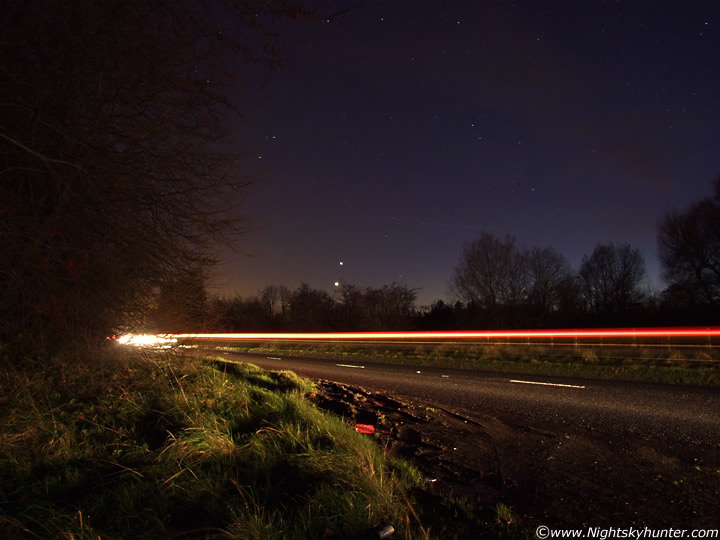 |
17.49 UT. I was quite happy with the way in which this image turned out. The aperture was closed a little and ISO at 200 with a 30 sec exposure. Venus is behind the branches of that tree. There's the trail of plane in there too. The stars of Capricornus are to the L. Aquila and Scutum to the R of centre, and Ophiuchus to the far R.
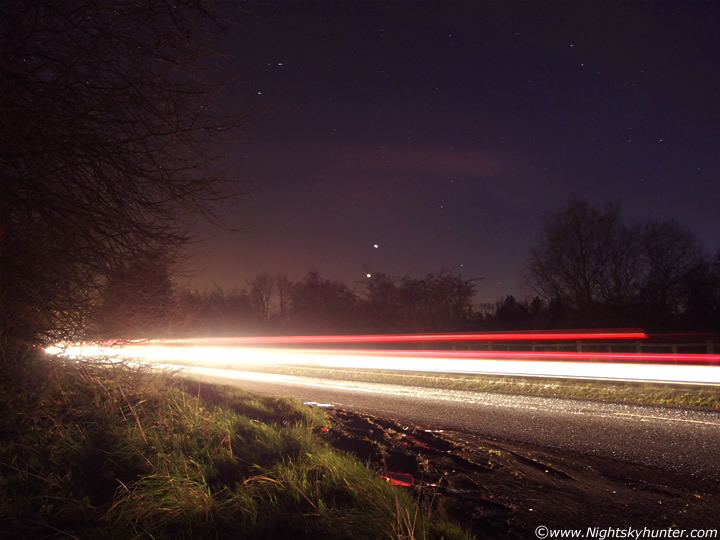 |
17.52 UT. Trailing of the stars and planets is obvious on this one. I actually caught a beauty of an image with great colourful car trails with plenty of stars but it turned out to be badly focused which was a pity. I headed home while watching the planets set and admired the stars and brilliant Milky Way over the trees. It had been a wonderful session. That conjunction between all three bodies was a joy to watch so I went back home feeling very content and happy. I had taken approximately 70 images and a selection of video clips in total. I enjoyed going through them all with a well deserved hot brew in hand while listening to Christmas songs on the television in the background!
Here's a youtube video clip I made showing the conjunction at various intervals during the session. Now it was time to find out the forecast for the big day tomorrow.
This was the big day I had been waiting for. I was trying not to get too excited because the forecast gave clouds and showers to arrive in my area before sunset, however the sky outside was painting a different picture. It was clear!. The Moon was due to occult Venus in daylight at 15.37 UT and by 15.30 I had the 8.5" F/7 reflector set up in the backyard looking south. Now I had to track down the Moon in daylight. Time was already ticking and an anxious scan across the southern sky with the naked eye showed nothing. There was some intricate patchy high level cloud in that area which obscured the Moon. I used my 10x50mm binoculars to sweep through that region of sky where I suspected the Moon to be but I had no luck. Now I was getting that combination of excitement and tension as I knew there were only a few min's left. I did another pass with the binoculars and bingo!, I found the Moon low in the sky above the neighbour's rooftop. It had abruptly popped into view when patchy cloud drifted away. Now I could see the crescent easily with the naked eye. I ran to the telescope and quickly centred the Moon in the field using the telrad finder. The view was amazing. The wide angle 32mm 2" eyepiece generated a wide field spanning almost two degrees in diameter. At centre was the cream coloured lunar crescent with a wealth of impact craters and to the E of this was a beautiful white pearl. This was the disk of Venus. The pair were stunning in such close proximity to one another, and the effect was even more striking against a blue daylight sky. Although the sky was too bright to see earthshine I mentally pictured where the limb of the invisible dark side of the Moon would be using the horns as a guide. It seemed Venus would vanish any time.
I ran inside and brought out the camera and tripod. I figured I might as well have a go at catching this since it doesn't happen very often. I used the 300mm lens and took one test shot. Checking it on the LCD screen I could see it was overexposed and not well focused. I zoomed in using the keypad and was shocked to see that I had both the Moon and Venus on the image!. I took two more darker shots and when I checked these the Moon was present but Venus was not. Another glance through the eyepiece confirmed my suspicions, Venus had just been occulted!. It was incredible to think it was now behind the Moon. The time on my mobile phone said 15.37, it was bang on time. I then realized that the first image I took had captured Venus just sec's from occultation. Talk about timing!. It was a thrilling sight, at least if it did cloud over I would be happy enough just to have seen that. The planet would reappear from behind the Moon at 17.07 UT. If I could observe that too then I would be very happy. The sky was even more impressive than before with barely a cloud in sight, maybe the forecasters got it wrong. I made some quick lunch to get some much needed energy then I headed back out the road for round two.
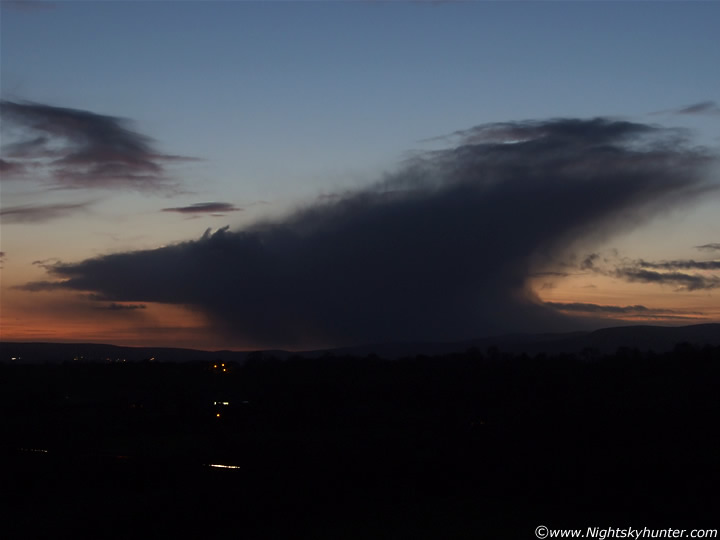 |
16.51 UT. I went back to the same location I had chosen yesterday and again the sky was glorious from here. Clear and blue with a nice orange band along the horizon. A scattering of nice red lenticular clouds gave me something to enjoy as I waited. It was another freezing evening and not long after I had arrived I already noted a significant drop in the temperature. The forecast was sort of accurate, however it was nowhere near as bad as indicated by the cloud maps on television earlier. I couldn't resist taking this image. Looking W at a weak cumulonimbus cell over the Sperrins. This was the only thing threatening in view. It was delivering a heavy shower of sleet over the hills. Bit of an anvil on it with sinking air at the rear. Those dark fingers pointing up from the L were strange looking. This was moving towards the planets so I was concerned it would cover the show. Behind it where two more in the NW. I hoped this wasn't the start of more sinister stuff to come. If only I could see Venus before it clouded over.
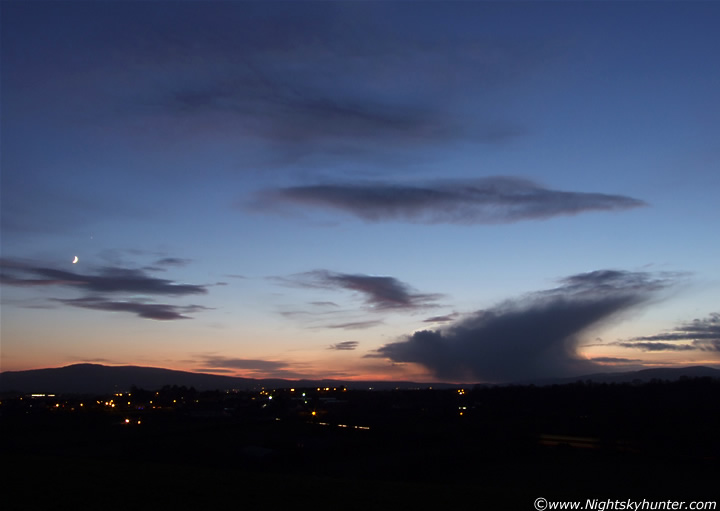 |
16.53 UT. I had nothing to worry about. The showers weakened rapidly and as the cell approached the Moon its canopy collapsed down leaving the Moon in full view. Here's a wide shot showing the cell with Jupiter and the Moon to the far L.
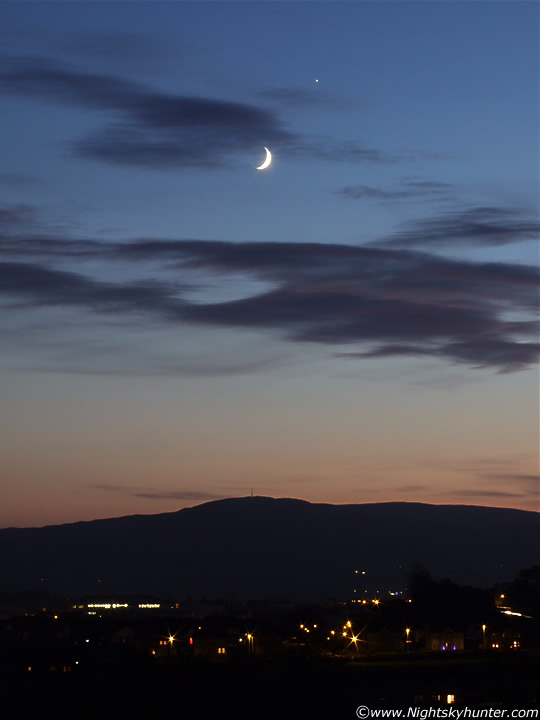 |
17.00 UT. This was a strange sight compared with what I seen at this time yesterday evening. There's one less planet in the sky!. Venus was still behind the Moon which is now showing obvious earthshine. I liked the purple colour to those clouds. I still had some time left before Venus appeared again but I couldn't help checking the time every few min's in a panic incase I hadn't read it properly the first time. It won't be long now!. More on page two.
Martin McKenna